Z68 SSD Caching with Corsair's F40 SandForce SSD
by Anand Lal Shimpi on May 13, 2011 3:06 AM ESTAnandTech Storage Bench 2011 - Heavy Workload
Last year we introduced our AnandTech Storage Bench, a suite of benchmarks that took traces of real OS/application usage and played them back in a repeatable manner. I assembled the traces myself out of frustration with the majority of what we have today in terms of SSD benchmarks.
Although the AnandTech Storage Bench tests did a good job of characterizing SSD performance, they weren't stressful enough. All of the tests performed less than 10GB of reads/writes and typically involved only 4GB of writes specifically. That's not even enough exceed the spare area on most SSDs. Most canned SSD benchmarks don't even come close to writing a single gigabyte of data, but that doesn't mean that simply writing 4GB is acceptable.
Originally I kept the benchmarks short enough that they wouldn't be a burden to run (~30 minutes) but long enough that they were representative of what a power user might do with their system.
Not too long ago I tweeted that I had created what I referred to as the Mother of All SSD Benchmarks (MOASB). Rather than only writing 4GB of data to the drive, this benchmark writes 106.32GB. It's the load you'd put on a drive after nearly two weeks of constant usage. And it takes a *long* time to run.
First, some details:
1) The MOASB, officially called AnandTech Storage Bench 2011 - Heavy Workload, mainly focuses on the times when your I/O activity is the highest. There is a lot of downloading and application installing that happens during the course of this test. My thinking was that it's during application installs, file copies, downloading and multitasking with all of this that you can really notice performance differences between drives.
2) I tried to cover as many bases as possible with the software I incorporated into this test. There's a lot of photo editing in Photoshop, HTML editing in Dreamweaver, web browsing, game playing/level loading (Starcraft II & WoW are both a part of the test) as well as general use stuff (application installing, virus scanning). I included a large amount of email downloading, document creation and editing as well. To top it all off I even use Visual Studio 2008 to build Chromium during the test.
The test has 2,168,893 read operations and 1,783,447 write operations. The IO breakdown is as follows:
| AnandTech Storage Bench 2011 - Heavy Workload IO Breakdown | ||||
| IO Size | % of Total | |||
| 4KB | 28% | |||
| 16KB | 10% | |||
| 32KB | 10% | |||
| 64KB | 4% | |||
Only 42% of all operations are sequential, the rest range from pseudo to fully random (with most falling in the pseudo-random category). Average queue depth is 4.625 IOs, with 59% of operations taking place in an IO queue of 1.
Many of you have asked for a better way to really characterize performance. Simply looking at IOPS doesn't really say much. As a result I'm going to be presenting Storage Bench 2011 data in a slightly different way. We'll have performance represented as Average MB/s, with higher numbers being better. At the same time I'll be reporting how long the SSD was busy while running this test. These disk busy graphs will show you exactly how much time was shaved off by using a faster drive vs. a slower one during the course of this test. Finally, I will also break out performance into reads, writes and combined. The reason I do this is to help balance out the fact that this test is unusually write intensive, which can often hide the benefits of a drive with good read performance.
There's also a new light workload for 2011. This is a far more reasonable, typical every day use case benchmark. Lots of web browsing, photo editing (but with a greater focus on photo consumption), video playback as well as some application installs and gaming. This test isn't nearly as write intensive as the MOASB but it's still multiple times more write intensive than what we were running last year.
As always I don't believe that these two benchmarks alone are enough to characterize the performance of a drive, but hopefully along with the rest of our tests they will help provide a better idea.
The testbed for Storage Bench 2011 has changed as well. We're now using a Sandy Bridge platform with full 6Gbps support for these tests. All of the older tests are still run on our X58 platform.
AnandTech Storage Bench 2011 - Heavy Workload
We'll start out by looking at average data rate throughout our new heavy workload test:
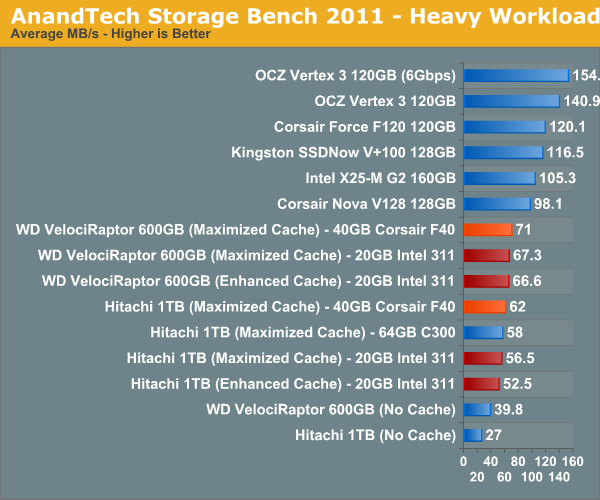
In our launch article we found that even Crucial's 64GB RealSSD C300 wasn't able to significantly outperform the 311, the situation isn't much different with the F40. The good news is that you do get twice the capacity and technically better performance, which could result in more of your data being in the cache at once.
The breakdown of reads vs. writes tells us more of what's going on:
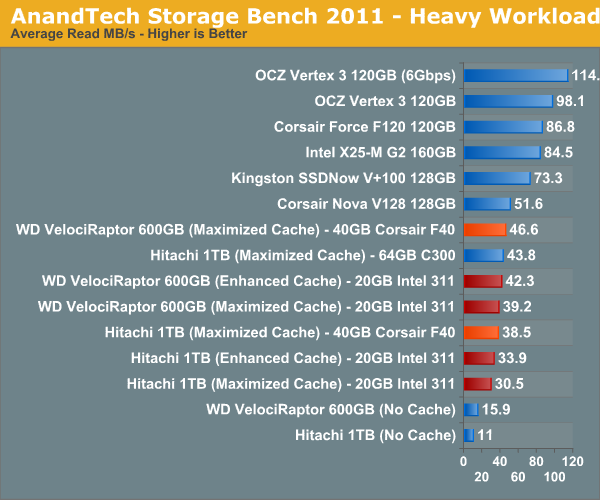
Read performance is actually where the F40 shines, surprisingly enough. This would imply that the majority of reads being cached are highly compressible in nature, playing to the F40's strengths. The write performance is a different story however:
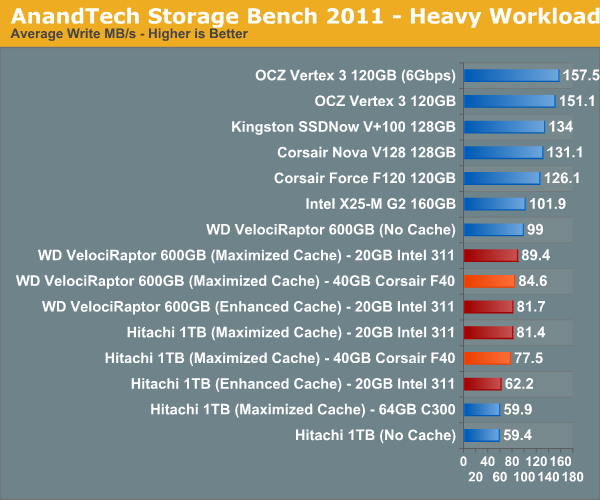
There isn't a huge difference here, but the 311 does pull ahead in the writes that occur during our test. Overall I'd say the F40 and 311 are pretty equal here, which is a good thing given the capacity advantage.
The next three charts just represent the same data, but in a different manner. Instead of looking at average data rate, we're looking at how long the disk was busy for during this entire test. Note that disk busy time excludes any and all idles, this is just how long the SSD was busy doing something:
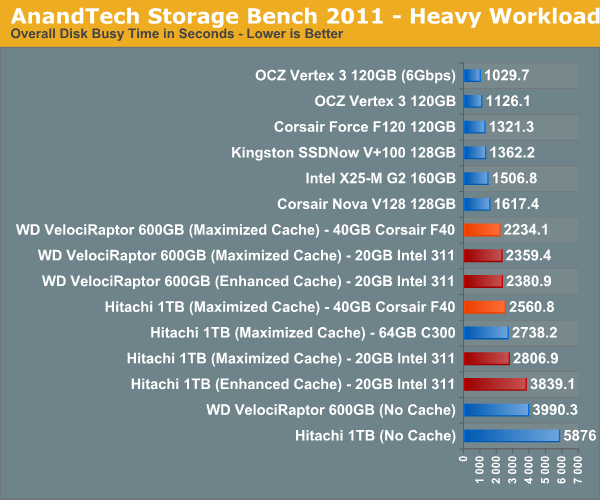

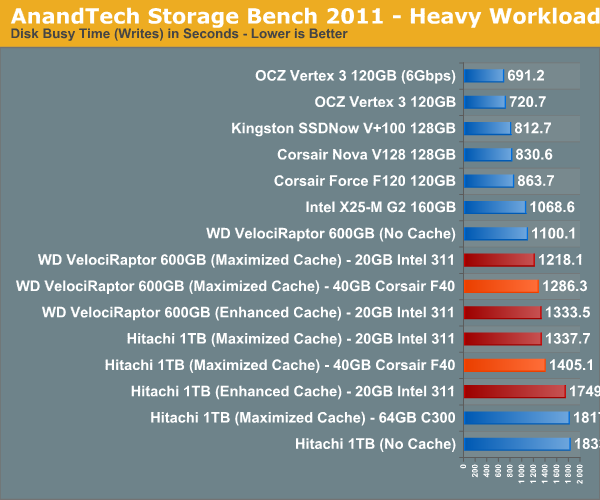










81 Comments
View All Comments
hechacker1 - Friday, May 13, 2011 - link
Agreed. I wonder if anybody can hack the RST 10.5 driver to make it work on any intel chipset.I actually just modded my X58 bios to include the new Intel Raid option rom, version 10.5.0.744. Guess what? The Acceleration Options shows up in the raid bios.
Unfortunately, I don't have an SSD to see if it will work.
I also tried an even newer option rom, and that Acceleration Option is now grayed out...
Either way, this is just software it seems.
Anandtech, any idea if the z68 chipset has some hardware responsible for enabling cache?
mianmian - Friday, May 13, 2011 - link
The write frequency on the catching drive is much more frequent than a normal disk. MLC might not have enough endurance to survive long under this kind of load.Shadowmaster625 - Friday, May 13, 2011 - link
I would rather just manage two drives, and move whatever I'm not using over to the media drive. It's not that hard; it only takes a couple clicks to move a folder from drive C to drive E. And for people who are scared to death of performing such types of operations, I doubt they'd see a reason to justify an extra $100. They can just suffer with a single drive solution. At least until the SSD cache is reduced to no more than a $20-$40 premium. I still think an integrated flash controller and a SSD DIMM is the way to go, and intel is shooting themselves in the foot with this half*** solution. A 10 channel SSD controller built into the cpu would be so blazingly fast...qwertymac93 - Friday, May 13, 2011 - link
Hmm, price of 40gig Corsair force = $110Price of 60gig vertex 2 = $105
... Am i missing something here?
cactusdog - Friday, May 13, 2011 - link
The features of this platform sounded great on paper but in reality a bit of a letdown.For people with a SSD this caching thing is useless.
I'm guessing AMD/Nvidia's next gen cards will have a quicksinc like performance built into their gpus, making sandy bridge/Quicksinc not so attractive.
Sata 6GBs is nice but anyone can get that speed on older boards with a pci-e ssd or just RAIDing 2 SSDs.
The only really attractive thing is unlocked CPUs for a reasonable pric but. I'm gonna skip this platform........ by the end of the year this platform will look very average.
assafb - Friday, May 13, 2011 - link
1) A more useful configuration would have been the SandForce 40GB on Enhanced mode, but it has only been tested as maximized?2) A power user would use an SSD as the boot drive naturally, SSD caching alone would be inferior, of course, but that is not all that there is to it with SSD caching for the power user. This is the question - whether the 160GB mainstream SSD buyer that has a mainstream 2TB HD would be better off with a 160GB boot drive and no caching, or with 40GB partitioned out of his 160GB SSD to cache the HD and the remaining 120GB partition for the boot drive and critical apps. This question is relevant as for many users like myself, OS+apps+games exceed 160GB, and even the unaffordable 256GB+ SSDs, so some apps and games still have to get to the mechanical HD.
Anand Lal Shimpi - Friday, May 13, 2011 - link
1) Enhanced mode should perform similarly to maximized mode in read performance. Write performance should be lower, at least on the Hitachi drive.2) If you can fit your OS and apps on the 120GB partition, then the 120/40 setup is your best bet for tackling games in my opinion.
Take care,
Anand
assafb - Saturday, May 14, 2011 - link
Thanks!sparky0002 - Friday, May 13, 2011 - link
Go for broke. Build the quickest array you can behind a z68 chipset then throw a cache infront of it. It would suck if it ended up as the limit rather than as a booster. My guess is enhanced mode will perform better.but what I really want to know is... I've lived my life inside a 60gb partition for years. Games and the like are on another disk. so how would three SSD 311's in raid 0 V's a Revodrive go? No cache just a straight test of the SLC drives.
don_k - Saturday, May 14, 2011 - link
'so how would three SSD 311's in raid 0 V's a Revodrive go'Not even close. The first gen revodrive does 500MB/s read/writes. Second gen doubles those numbers. So three 311 would give you maybe ~300MB/s at a higher price than a first gen revodrive.